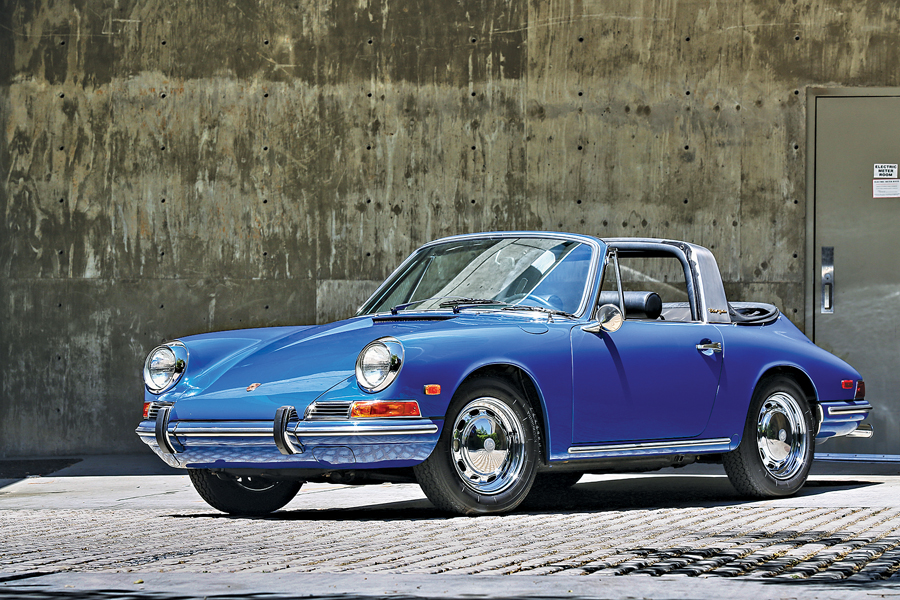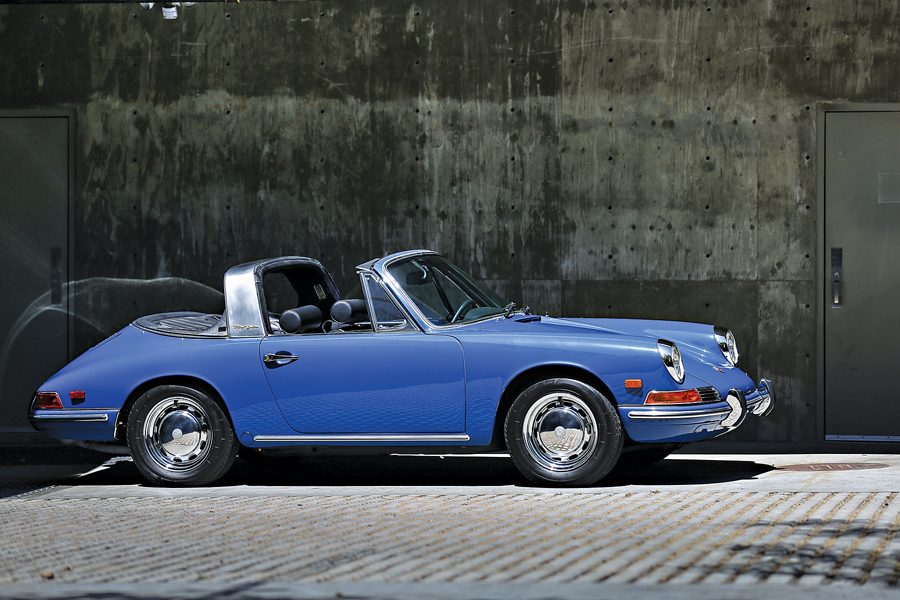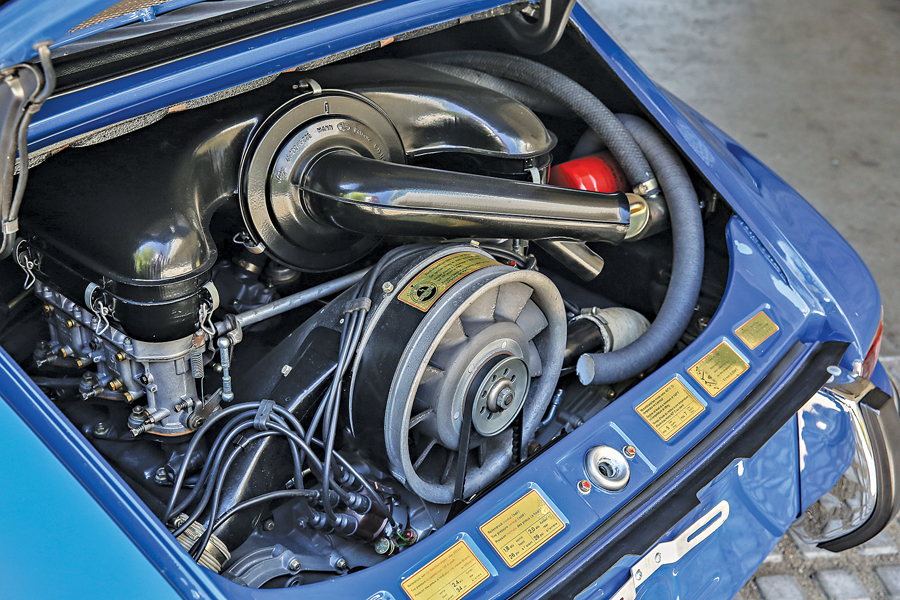SCM Analysis
Detailing
| Vehicle: | 1968 Porsche 911 Soft-Window Targa |
| Years Produced: | 1968 |
| Number Produced: | Total production of 1968 911s was 16,934 cars. Of that number, 6,672 Targas were made. There were 268 base-model Targas (s/n 11880001–268) made. There were 5,134 911L Targas made (s/n 11850001–11855134). |
| Original List Price: | Base 911 Targa in the U.S. with no options, $6,590 |
| SCM Valuation: | $148,000 |
| Tune Up Cost: | $1,500 |
| Chassis Number Location: | Aluminum tag on front lip inside trunk; stamping on cross member passenger’s side above gas tank; aluminum tag on driver’s side A-pillar |
| Engine Number Location: | Passenger’s side of fan upright support |
| Club Info: | Porsche Club of America; Early 911S Registry |
| Website: | http://www.pca.org |
| Alternatives: | 1968 Chevrolet Corvette 427/400, 1966–68 Ferrari 330 GTC, 1968–71 Jaguar E-type Series II 4.2 |
| Investment Grade: | A |
This car, Lot 15, sold for $148,500, including buyer’s premium, at Gooding & Company’s Pebble Beach, CA, auction on August 18, 2017.
This Porsche was a fresh restoration from a well-known shop of a desirable model in a very desirable color. Why did it sell for short money?
First, a little history:
1968 was a transition year for Porsche in the United States. Through the 1967 models, Porsche’s already venerable 1,991-cc, 6-cylinder engine had ranged from 110 horsepower to 160 horsepower depending on year and model.
The 911 engine was a substantial departure from the previous 356 iterations. In addition to the two additional cylinders, the engine had dual overhead camshafts — one for each 3-cylinder bank — dry-sump lubrication with eight-bearing crankshafts, and usually triple-throat Solex carburetors, one throat for each cylinder.
The case was alloy and the cylinders were “Biral,” finned aluminum with iron sleeves for good wear characteristics. A freshly designed Type 901 5-speed gearbox was introduced, with first gear out of the H pattern, for accomplished sporting driving — but also a drag around town. That setup was changed over with the 915 box introduced in 1972, where fifth gear went outside the H.
Early 911s were winners
The 911’s power-to-weight ratio was considered advantageous. With a well-developed suspension — and despite the threat of trailing throttle oversteer — the cars were successful in circuit racing, hillclimbs and road rallies.
They most often won the under-2-liter classes, sometimes overall, as in the Monte Carlo rallies of the mid- and late 1960s. In the United States, they were frequent 2-liter class winners in SCCA’s Trans Am Series. These successes registered with the many U.S. race fans who attended those races to enjoy the “ground-pounders,” 302-ci (5.0-liter) muscle cars from Ford and Chevrolet, and later Pontiac and American Motors as well.
A single model 911 had served Porsche well from introduction in 1964 through 1966, when the uprated 911S was introduced. With lightweight aluminum alloy-forged Fuchs wheels, a changeover to Weber carbs, a modified valve train, and a rear sway bar for the first time, the 911S put an exclamation mark behind “911” with an extra 30 horsepower — up to 160.
Porsche had an “oops” year
For the 1968 models, the U.S. implemented its first emissions laws, and Porsche was caught short.
The 911S could not be cleaned up and was not available in the U.S. The base-model 911 was offered, along with the one-year-only 911L, which was the base 911 dolled up with S trim and options. Porsche 911s sold in California got the dreaded smog pump. The 130-horsepower engine was standard fare. For 1969, Porsche moved to the more-efficient, cleaner-burning Bosch mechanical fuel injection system (known as “MFI”), and also to the now-famous, three-model lineup: 911T, 911E and 911S. This lineup survived through 1973. Porsche also increased the wheelbase to a more roadworthy 2,268 cm (up 57 cm from 2,211), giving birth to the SWB (vs. LWB) long-hood 911s.
The Targa is born
As discussed in our SCM profile of the Porsche 901 prototype cabriolet (May 2017, “German Profile,” p. 76), Porsche initially rejected a convertible for the new 901 based on their latter-year sales of 356 cabs and the state of the market for convertibles in general.
Porsche soon second-guessed that decision and considered a cabriolet model. They built at least one prototype but found it too flexible to put into production. They did develop a way to make a 911 cabriolet work — add a roll bar or cage. Initially Porsche marketing people rejected that, but it was rethought to beget the Targa, with a roll bar handsomely encased in a brushed aluminum band.
Introduced in mid-1966, the Targa featured a removable front section and a soft rear window that unzipped and folded into the rear cockpit. The “softie” was changed to a hard glass rear window for 1969, although the soft-window could be special ordered through the 1971 models.
Our Ossi Blue “softie”
The Gooding auction subject car was a base-model 1968 911 with the 130-horsepower engine and base-model steel wheels — here optionally chromed. During its restoration the engine reportedly was built up to S specs, and Pepita (black-and-white check) cloth seat inserts — a desirable look these days — were added to the interior.
The engine and gearbox numbers matched the Kardex, which was available for viewing. The color was also original — the very desirable Ossi Blue. And lastly, the Targa top was the early soft-window style, also now in vogue.
This car carried a readily saleable specification. Gooding estimated its pre-sale in the range of $175,000–$200,000 but offered it with no reserve price, as is common for Gooding and RM Sotheby’s when they expect a car to sell under $250,000. If the car had been a trimmed-up 1968 911L model, the estimates would have been a little higher.
If the car had been a rest-of-the-world spec 911S, the pre-sale estimates would have been $50,000 to $75,000 higher.
On the block, the Ossi Blue Targa hammered at $135,000 for a total of $148,500, including the 10% buyer’s premium. For reference, the next day Gooding offered a quite presentable Polo Red 1967 911S soft-window Targa (Lot 113) with an estimate of $275,000 to $350,000. It was a no-sale on the block, but it sold later that day for $285,000.
What happened?
I believe that bidders knocked down the Ossi Blue car because it did not present very well. I spent a few minutes looking at the car and dismissed it.
Unfortunately, I did not evaluate it for original metal vs. rust repair. What I did see was that some of the fitment was a tad random. Some of the trim was worn, especially the very visible Targa top seals. Other parts of the trim were reproduction, while some hoses, clamps and brackets were less than tidy. Finally, the indicated mileage was high at over 100,000.
All that said, the car could have gone for more. The new owner can detail the car and increase its value. I’ll call it well bought. ♦
(Introductory description courtesy of Gooding & Company.)



